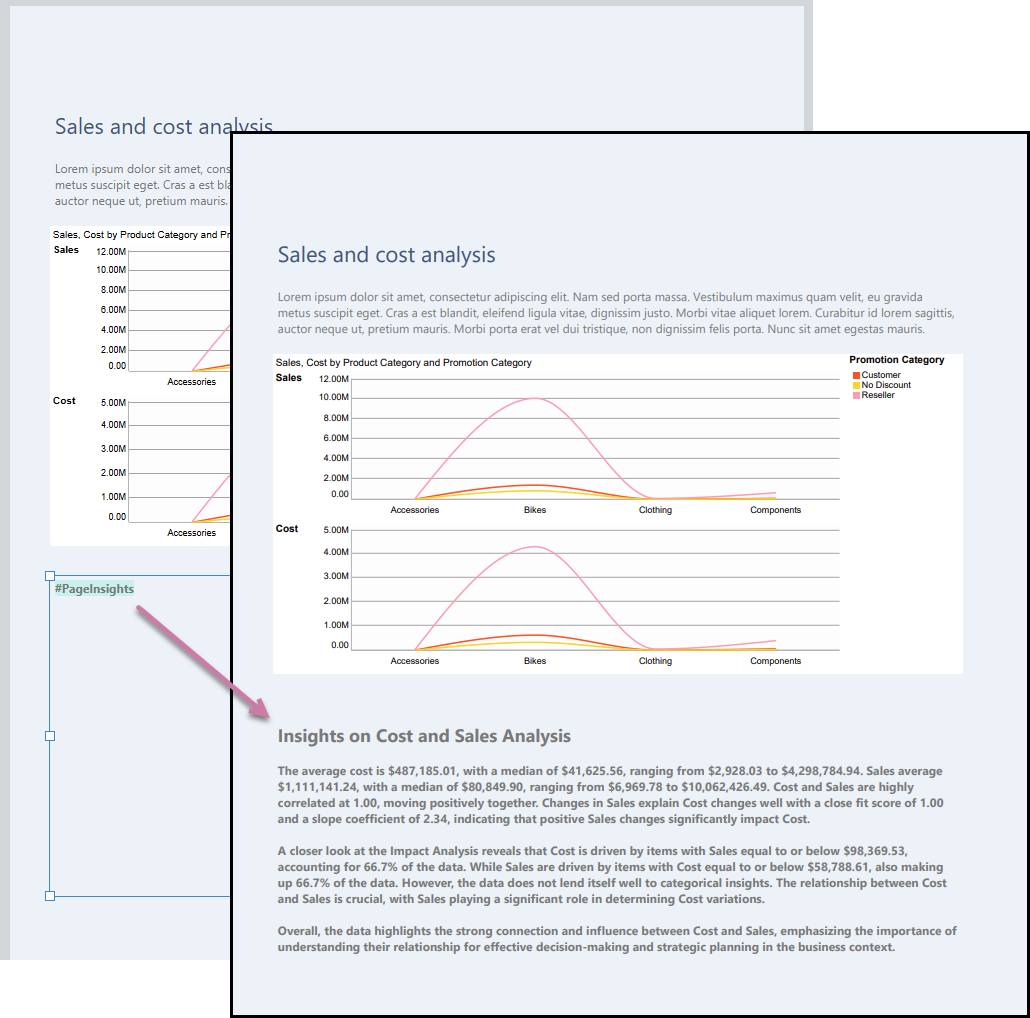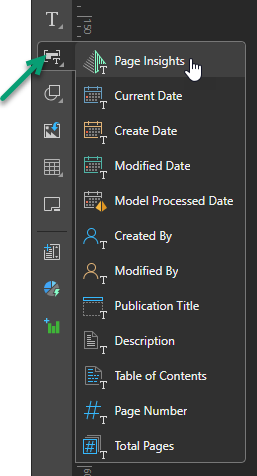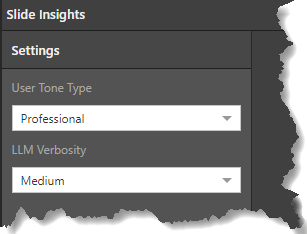A "Page insight" is a natural language analysis of a page that is dynamically generated at build time using AI. Insights can be added to your page as variable text fields and provide your reader with a textual analysis of the content of the current page. They also reflect the filtering applied in the page; for example, if you are building a PDF that describes the Sales in a particular region, the region filter affects visuals and related insight information.
You can add a variable text field that includes a #PageInsight tag to any page in your publication. Page insights are generated in your Application Language and contain analytic information about the content (visuals and applied slicers) in the built page.
It is important to note that the content is generated each time Pyramid builds your publication and may be different every time.
Note: You can only make use of this functionality if your administrator has selected to Enable Generative AI in the AI Settings page of the Admin Console. Otherwise, the function is not available for use.
Warning: When using LLMs, your assets are generated using public domain algorithms. This can produce erroneous and inconsistent or random results. Use at your own risk.
Page Insights Content
When you open a page in your output publication, any Page Insight variable text field is replaced with a block of generated text in your Application Language. The text is "analytic," describing the content of the page that the variable appears on including applied filters. It is typically a paragraph or two, although this may depend on your Settings.
What does the insight look like?
The #pageInsights tag is replaced with a paragraph of analytic text when the publication is built.
The replacement text describes visuals on the page and reflects any filtering that was applied at build time:

What content does the insight contain?
Insights text is "analytic" describing the content of the page, including any applied filters and optionally also incorporating a "fairness analysis." The insights content is typically a paragraph or two, although this may depend on your Settings.
- Click here for more information about Insights content
Adding Page Insights
Open the page
Either open the page that you want to add your insights to from the Pages panel or create a new page from that same panel.
Add insights manually
From the Toolbox:
- Right-click Add Text Field > Page Insights.
-
Click the canvas at the point where you would like to add the text field.
- Select the
#PageInsightstext field on the canvas. - Optionally, specify the settings for your Page Insights.
- Click Apply.

Clicking creates a standard sized text field. Alternatively, you can drag your cursor across the canvas to draw a box indicating the size of the item when it is dropped.
The Page Insights panel opens at the bottom of the page.
These options allow you to control the tone type and verbosity used by the LLM when generating the replacement text. For more information, see Settings.
Tip: You should remember that the generated insights information will use up a lot more space than the variable it is replacing. You might, therefore, want to make the text box quite large and manually build a PDF to check the amount of text you might need to accommodate.
Add insights using the Chatbot
If you include a request to add Page Insights explicitly to your prompt (you say or type "add insights" into the Chatbot), a Page Insights text field (a text field containing the variable #PageInsights) is added to your publication as part of the process.
- Click here for more information about the Chatbot
- Click here to learn about creating a publication using the Chatbot
Editing and Deleting #PageInsights
You can edit and delete #PageInsights as you would any other text field or variable text field. Be aware that the #PageInsights tag may be replaced with a considerable amount of text and plan its appearance and position in your publication accordingly.
- Click here for more information
Settings
Open the Settings dialog by clicking the variable on the canvas:

These settings are used by the LLM when generating the Insights:
- User Tone Type: Sets the appropriate tone for the insight message. This can be one of a set of tone values ranging from Professional to Whimsical.
- LLM Verbosity: Sets the level of detail to use for the explanation in the generated insights. This can be one of Low, Medium, or High.
Tip: If you *always* want to select a particular Tone type or Verbosity, you should reset your user defaults to save time in future. For more information, see User Defaults.